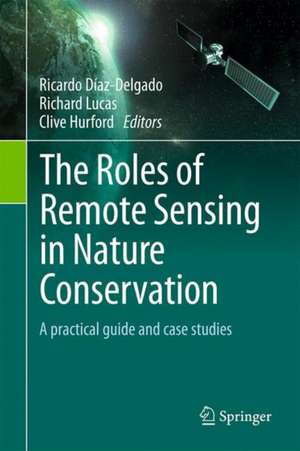The Roles of Remote Sensing in Nature Conservation: A Practical Guide and Case Studies
Editat de Ricardo Díaz-Delgado, Richard Lucas, Clive Hurforden Limba Engleză Hardback – 20 noi 2017
This book and linked activities have been selected as finalists of the European Natura 2000 award 2020.
https://natura2000award-application.eu/finalist/3126
| Toate formatele și edițiile | Preț | Express |
|---|---|---|
| Paperback (1) | 837.05 lei 38-44 zile | |
| Springer International Publishing – 11 sep 2018 | 837.05 lei 38-44 zile | |
| Hardback (1) | 1006.72 lei 6-8 săpt. | |
| Springer International Publishing – 20 noi 2017 | 1006.72 lei 6-8 săpt. |
Preț: 1006.72 lei
Preț vechi: 1227.70 lei
-18% Nou
Puncte Express: 1510
Preț estimativ în valută:
192.66€ • 199.03$ • 160.34£
192.66€ • 199.03$ • 160.34£
Carte tipărită la comandă
Livrare economică 26 martie-09 aprilie
Preluare comenzi: 021 569.72.76
Specificații
ISBN-13: 9783319643304
ISBN-10: 3319643304
Pagini: 320
Ilustrații: XII, 318 p. 102 illus., 64 illus. in color.
Dimensiuni: 155 x 235 mm
Greutate: 0.64 kg
Ediția:1st ed. 2017
Editura: Springer International Publishing
Colecția Springer
Locul publicării:Cham, Switzerland
ISBN-10: 3319643304
Pagini: 320
Ilustrații: XII, 318 p. 102 illus., 64 illus. in color.
Dimensiuni: 155 x 235 mm
Greutate: 0.64 kg
Ediția:1st ed. 2017
Editura: Springer International Publishing
Colecția Springer
Locul publicării:Cham, Switzerland
Cuprins
1. Introducing the Book “The Roles of Remote Sensing in Nature Conservation”.- 2. Towards a Mature Age of Remote Sensing for Natura 2000 Habitat Conservation: Poor method transferability as a prime obstacle.- 3. Pre-processing of Remotely Sensed Imagery.- 4. Long-term Ecological Monitoring at Landscape Scale for Nature Conservation: The example of Doñana protected area.5. NILS - A Nationwide Inventory Program for Monitoring the Conditions and Changes of the Swedish Landscape.- 6. Mapping Coastal Habitats in Wales.- 7. Integrated Monitoring for Biodiversity Using Remote Sensing: From local to regional.- 8. Sub-pixel Mapping of Doñana Shrubland Species.9. Mapping the Distribution of Understorey Rhododendron ponticum Using Low-tech Multispectral UAV Derived Imagery.- 10. The Potential of UAV Derived Image Features for Discriminating Savannah Tree Species.- 11. A Toolbox for Remotely Monitoring Large Carnivores in Sweden.- 12. Coupling Field Sampling with Earth Observation Increases Understanding of Tiger Movement and Behaviour.- 13. Improving the Accuracy of Bird Counts Using Manual and Automated Counts in ImageJ: An Open-Source Image Processing Program.- 14. Using UAVs to Map Aquatic Bird Colonies.- 15. The Integrated Land Cover and Change Classifications.- 16. Expected Advances In a Rapidly Developing Work Area.
Notă biografică
Dr. Ricardo Diaz-Delgado, CSIC-Estación Biológica de Doñana EBD, Sevilla, Spain
Prof. Richard Lucas, The University of New South Wales, School of Bio., Earth, Env. Science, Kensington, Australia
Dr. Clive Hurford, Natural Resources Wales, Pembroke Wales, United Kingdom
Textul de pe ultima copertă
During recent decades, a rapid increase in available data sources has enabled researchers to develop hundreds of new remote sensing applications: data provided by new sensors attached to satellites, aircrafts and drones. However, a major challenge remains unresolved: how to transfer the knowledge of these technological advances to conservation practitioners and facilitate access to the remote sensing products that are currently available. In this volume, we illustrate the ability of new technologies, such as drones, camera traps or miniaturized sensors, to enhance our information on habitat condition, species occurrence, invasive species mapping or biodiversity.
There are several case studies from Natura 2000 and LTER sites: these were designed to meet the requirements of the EC Birds and Habitats Directives and the commitments associated with the EU Biodiversity Strategy, including regular habitat assessments. The authors of this volume, who work for different conservation and research agencies, provide a practical perspective on how remote sensing applications can benefit these long-term monitoring or surveillance programs.
With these requirements in mind, the time is now right for conservation ecologists, researchers, technicians, managers, policy makers and practitioners to embrace the new technologies and products that are available from the remote sensing community.
There are several case studies from Natura 2000 and LTER sites: these were designed to meet the requirements of the EC Birds and Habitats Directives and the commitments associated with the EU Biodiversity Strategy, including regular habitat assessments. The authors of this volume, who work for different conservation and research agencies, provide a practical perspective on how remote sensing applications can benefit these long-term monitoring or surveillance programs.
With these requirements in mind, the time is now right for conservation ecologists, researchers, technicians, managers, policy makers and practitioners to embrace the new technologies and products that are available from the remote sensing community.
Caracteristici
The chapters provide real examples of remote sensing techniques applied to map a range of indicators required by conservation managers, such as habitat distribution and condition, biodiversity indicators or even individual plants with drones Special chapters on Remote sensing imagery preparation for ecological studies, assessment of the use of drones to map nesting bird colonies or invasive plant species Book sections lead the reader towards the specific application and every chapter provides practical lessons for nature conservation
